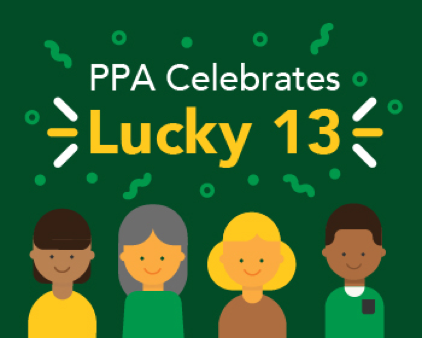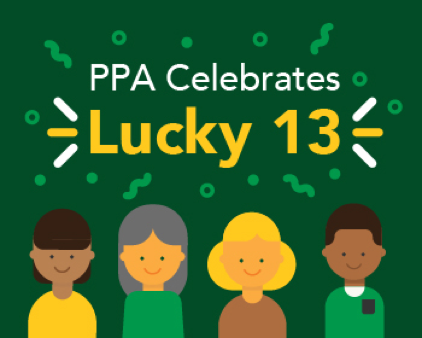 As of 2018, 13 is no longer an unlucky number, especially when it comes to health. This April, the Partnership for Prescription Assistance (PPA) is celebrating 13 years of connecting people who are uninsured and/or have limited health care coverage with public and private patient assistance programs that could provide them with the medicines they need for free or nearly free.
As of 2018, 13 is no longer an unlucky number, especially when it comes to health. This April, the Partnership for Prescription Assistance (PPA) is celebrating 13 years of connecting people who are uninsured and/or have limited health care coverage with public and private patient assistance programs that could provide them with the medicines they need for free or nearly free.
Since launching in 2005, PPA has connected more than 10 million people to patient assistance programs (PAPs), which serve as critical safety nets for the millions of Americans who lack health insurance or whose insurance does not sufficiently cover the cost of the medicines they need. In celebration of these 13 years, it is important to show you how it all began and how PPA has continued to evolve to fit patients’ needs.
Launching at a Crucial Time
PPA launched at a time when the number of people without insurance was at an all-time high. According to the U.S. Census Bureau, 46.6 million Americans were uninsured in 2005 – a 1.3 million increase from 2004. This was due in part to the number of people with employer-sponsored coverage declining, but it was also a product of the rising costs of insurance premiums. The challenges for patients lacking health insurance extended to prescription affordability and continue today.
In April 2005, America’s biopharmaceutical research companies joined forces with health care stakeholders across the country to launch PPA. Since then, the program has and continues to be a lifeline for patients who are struggling to access their medicines. These problems continue to this day. Each year, insurers and pharmacy benefit managers shift more of the costs of health care to patients. According to data from the Kaiser Family Foundation, since 2006, deductibles have increased 300 percent and there has been an 89 percent rise in what patients pay in coinsurance, which is a percentage of costs associated with their health care service or medicine. As the program has done for 13 years, it will continue to commit to the promise made to the American people when it first began: when the system fails you, PPA is here to help you get the medicines you need.
Always Adapting
PPA was a success from the beginning, connecting more than three million patients to PAPs within the first two years. By 2010, that number more than doubled, and PPA looked for a more modern approach to serve the people who visited PPA’s website for information.
Since launching, PPA has:
- Provided information on more than 475 public and private patient assistance programs, including 200 offered by biopharmaceutical companies.
- Added hundreds of new medicines, prescription assistance programs and free clinics to its database, which now serves an average of 75,000 visitors every month.
- Expanded its resources to educate more patients through videos, infographics and prescription assistance events across the country.
- Reached new communities by updating the Spanish website and translating videos and informational brochures into Spanish.
- Developed and launched a new mobile app that lets users search for patient assistance programs and explore a database of nearly 10,000 free or low-cost health care clinics across the country.
Poised for What Comes Next
More than 75,000 people visit the PPA website each month to find patient assistance programs, get information about disease-specific programs and much more. The need is still there and PPA will continue to evolve to meet patient needs.
As the program celebrates its 13th anniversary, updates will include a refreshed patient-centric effort as well as a renewed public awareness initiative. PPA has spent over a decade helping people access the medicines they need to live healthy and happy lives, and the program has no intention of slowing down.
If you or someone you love struggles with affordable access to medicines, there are resources available that may be able to help: The Partnership for Prescription Assistance (PPA) helps connect patients with patient assistance programs that provide free or nearly free prescription medicines. For more information, visit www.pparx.org.



 As of 2018, 13 is no longer an unlucky number, especially when it comes to health. This April, the Partnership for Prescription Assistance (PPA) is celebrating 13 years of connecting people who are uninsured and/or have limited health care coverage with public and private patient assistance programs that could provide them with the medicines they need for free or nearly free.
As of 2018, 13 is no longer an unlucky number, especially when it comes to health. This April, the Partnership for Prescription Assistance (PPA) is celebrating 13 years of connecting people who are uninsured and/or have limited health care coverage with public and private patient assistance programs that could provide them with the medicines they need for free or nearly free.